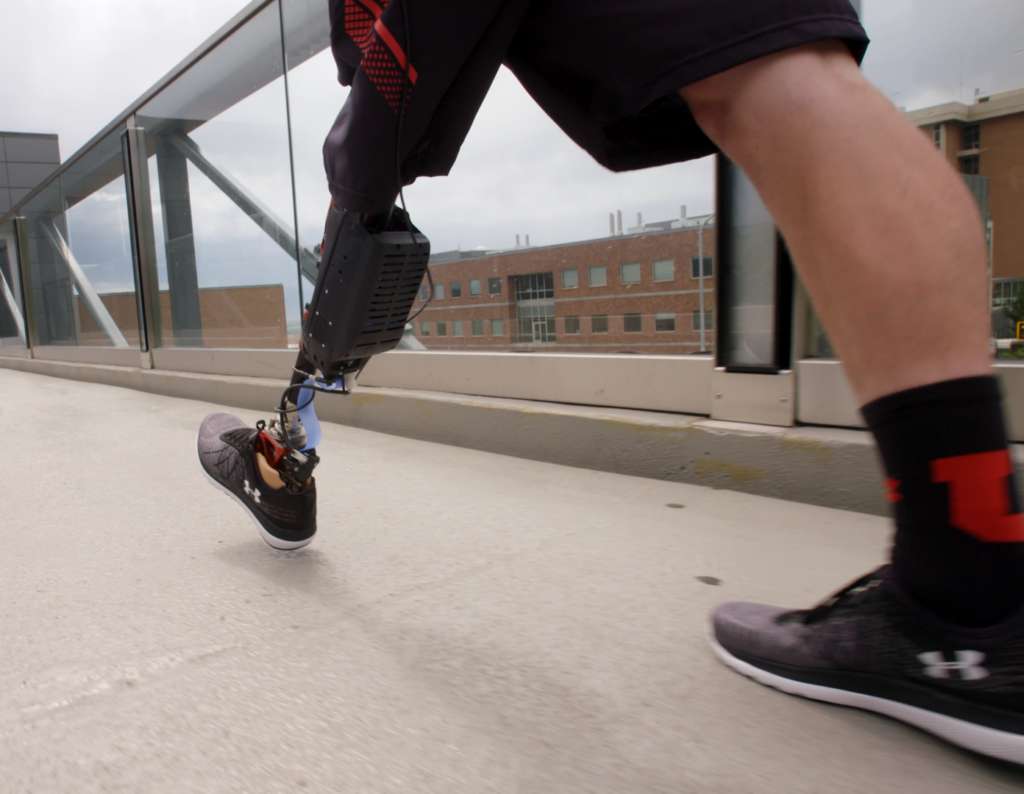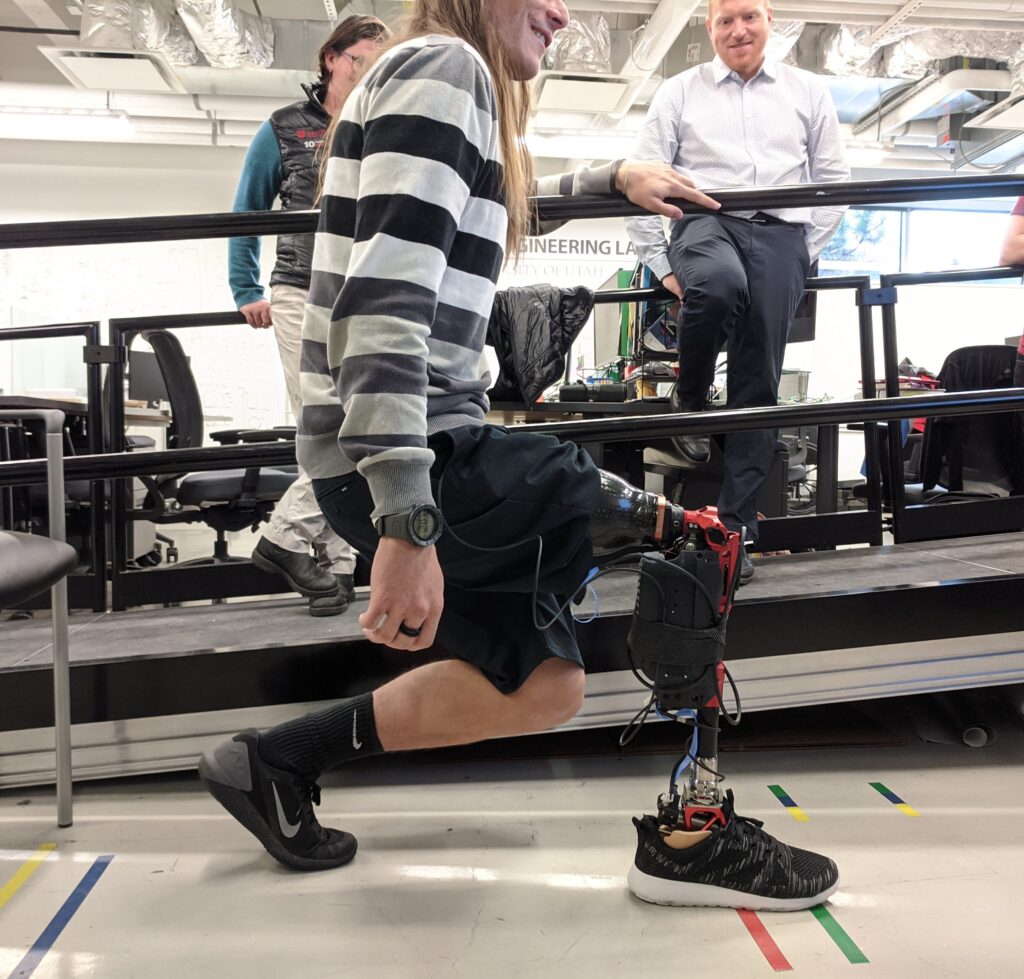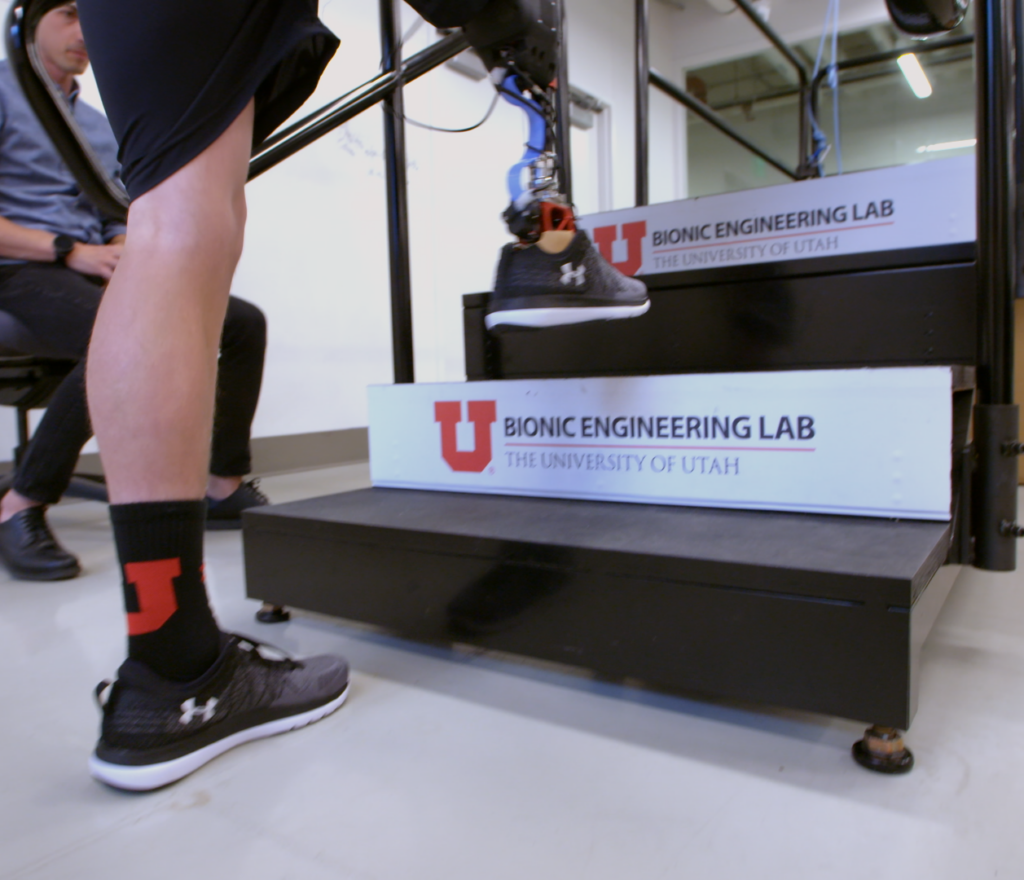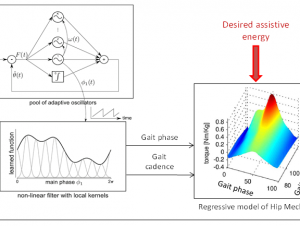EMG Control of Powered Prostheses
Powered knee prostheses need to coordinate their motion with the user. Most powered prosthesis controllers use mechanical sensors to estimate the user's intention, but with the wide range of activities performed in daily life, estimating the desired motion in every scenario becomes very complex. The EMG control project aims to simplify this problem by enabling users to control their knee prosthesis directly using the muscles of their residual limb.
Unified Controller for Ankle Prostheses

The Unified Controller for powered foot and ankle prostheses is built upon intrinsic biomechanical behaviors. Primarily, the virtual “stiffness” of the ankle joint is commanded as a function of the shank angle, enabling natural adaptation to uneven terrain and variable pushoff power based on step length. Furthermore, the virtual “damping” of the joint is commanded as a function of walking speed, enabling increased pushoff the faster you walk. Lastly, the position of the ankle is controlled synergistically with the knee, enabling biomimetic coordination between the joints of the lower leg. In combination, these control elements enable walking at variable speed and inclines, climbing stairs, sit-to-stand, and other activities of daily living.
Unified Control for Powered Knee Prostheses

The Unified Controller for Powered knee prostheses is a novel control strategy that enables walking, stair climbing, sit-to-stand, and other activities of daily living without classifying the intended activity or ambulation mode. Instead, the controller commands desired torques and positions based on the user’s movement of their residual thigh. We achieve this by combining a series of concurrently acting control elements that modulate the knee control as a function of the device’s sensor measurements. These control elements, such as knee-thigh synergy, minimum-jerk trajectory planning, and biarticular torque are biomimetic behaviors that enable natural ambulation across multiple activities without classification.
User-Adaptive Control of Powered Prostheses
 We developed a novel control architecture for robotic leg prostheses that adapts online at each step to provide a biological accurate function. The movement of the prosthesis during the swing phase adapts online to the specific user gait pattern using the minimum-jerk principle. Minimum-jerk provides an optimal way to program smooth movements, allowing amputees to obtain physiological gait symmetry at variable cadences, and potentially handling unexpected perturbations such as tripping. Read More.
We developed a novel control architecture for robotic leg prostheses that adapts online at each step to provide a biological accurate function. The movement of the prosthesis during the swing phase adapts online to the specific user gait pattern using the minimum-jerk principle. Minimum-jerk provides an optimal way to program smooth movements, allowing amputees to obtain physiological gait symmetry at variable cadences, and potentially handling unexpected perturbations such as tripping. Read More.
Shared Neural Control for Powered Prostheses
 We are developing a novel control approach for powered prostheses that combines the neural commands from the user's residual muscles with the mechanical sensors in the powered leg. This shared control approach provides users with the ability to voluntarily change the assistance provided by the powered prosthesis in a way that is both safe and intuitive. Ambulation tasks that benefits from this approach are standing up, squatting, and lunging.
We are developing a novel control approach for powered prostheses that combines the neural commands from the user's residual muscles with the mechanical sensors in the powered leg. This shared control approach provides users with the ability to voluntarily change the assistance provided by the powered prosthesis in a way that is both safe and intuitive. Ambulation tasks that benefits from this approach are standing up, squatting, and lunging.
Environment-Adaptive Control for Powered Protheses
 Available prosthesis controllers use machine learning to understand the surrounding environment and adapt the prosthesis function. While functional in the laboratory, this approach struggles to deal with the variability typical of the real world. To address this issue, we are developing new methods to continuously adapt the prosthesis behavior to the user needs without an explicit classification of the environment. Using this approach powered prosthesis users can ambulate on any kind of stairs step-by-step, step-over-step, and even two steps at the time.
Available prosthesis controllers use machine learning to understand the surrounding environment and adapt the prosthesis function. While functional in the laboratory, this approach struggles to deal with the variability typical of the real world. To address this issue, we are developing new methods to continuously adapt the prosthesis behavior to the user needs without an explicit classification of the environment. Using this approach powered prosthesis users can ambulate on any kind of stairs step-by-step, step-over-step, and even two steps at the time.
Adaptive Oscillator Control for Powered Exoskeletons
 Adaptive Oscillators are a mathematical tool that can learn any periodic signal and provide a smooth estimate of its phase and offset. By using this innovative tool, we moved from a time-based to a phase-based control system for powered exoskeletons that is more robust to natural movement variability. Experiments show that this control approach can effectively provide assistance by reducing the user effort during walking. Read More.
Adaptive Oscillators are a mathematical tool that can learn any periodic signal and provide a smooth estimate of its phase and offset. By using this innovative tool, we moved from a time-based to a phase-based control system for powered exoskeletons that is more robust to natural movement variability. Experiments show that this control approach can effectively provide assistance by reducing the user effort during walking. Read More.
